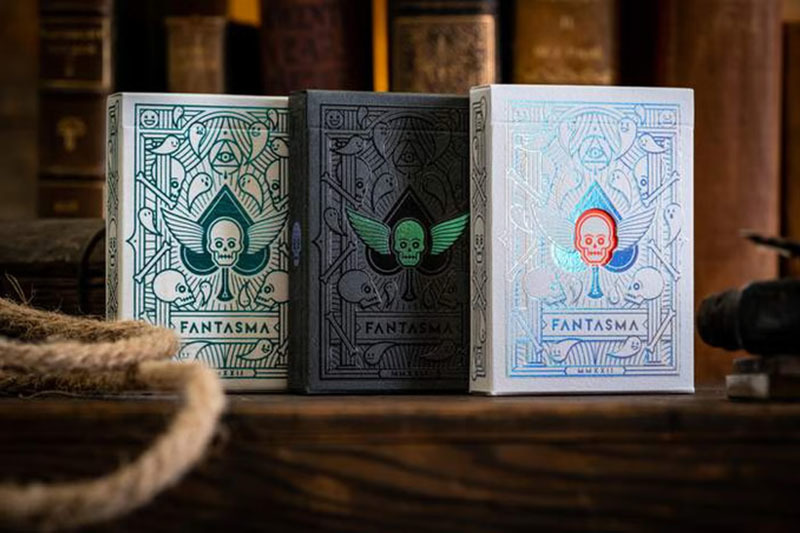Poker manufacturer's poker production process
2025-02-19
Playing cards are a common entertainment prop in life. Let's learn about the custom printing process of playing card manufacturers.
Playing card printing includes the following 15 steps (the steps may vary among different playing card manufacturers):
1) The playing card manufacturer arranges 54 playing cards in a 6x9 (54) or 7x8 (56) layout. Because some playing cards need to print 55 or 56 cards, the extra 1 or 2 cards are usually calendars or other advertising information. The paper is also cut to the corresponding size of 6x9 (54) or 7x8 (56).
2) Four-color printing on the front and back, and quality inspection. After printing, according to the ink absorption characteristics of the paper, wait for the ink to be fully absorbed by the paper before entering the next process.
3) Front filling and drying;
4) Back filling and drying. Filling is an important process in playing card production. The so-called "filling" is to apply a solution mixed with starch and other viscous chemical components evenly to the playing card paper through rollers. This is because any paper will always appear "uneven" under a microscope, and playing cards require very flat paper to ensure sufficient smoothness, and "filling" can make it flat. Because there is water in the slurry, it needs to be dried at a medium-high temperature of 70~80 degrees. [color=#0000CD](Now, due to machinery and equipment, the front and back filling can be combined into one process)[/color]
5) Steel roller pressing. Because the playing card paper is relatively thick and is composed of three or more layers, if it is not pressed, the front and back sides of the playing cards will separate after prolonged use. Ten years ago, domestically produced playing cards often had the problem of front and back separation, but now this problem has been completely solved in large-scale production plants. The pressing effect is better after "filling".
6) Coating. Coating is the process of applying a layer of colorless transparent coating (or spraying, printing) to the surface of the printed matter. After leveling, drying, pressing, and curing, a thin and uniform transparent bright layer is formed on the surface of the printed matter, playing a role in enhancing the smoothness of the carrier surface and protecting the printed graphics. Coating has become an important means of post-printing finishing for playing cards. It not only makes the playing card patterns look more exquisite, but more importantly, it is an important process for forming the moderately smooth feel of playing cards. The coating of playing cards should be determined according to the paper. If the coating is excessive, the playing cards will be too slippery and easy to fall off when stacked; if the coating is insufficient, the playing cards will be too rough, difficult to clean, and difficult to insert. (Note from the webmaster: Now the coating oil is applied after four-color printing. The brightness and smoothness of the playing cards are related to the type of coating oil used.)
7) Pressing fabric texture. Fabric texture effect can make the playing cards look more high-end, and many advertising playing card customers hope to have a fabric texture effect. The fabric texture machine consists of two parallel steel rollers. When the playing card paper passes through, the texture on the steel rollers is pressed onto the paper, forming a fabric texture effect. (Note: This process is usually done before or after filling by current manufacturers, and it has a certain impact on the stiffness and hardness of the playing card paper.)
8) Perfume. Some customers require playing cards to have a special fragrance, especially some food or cosmetics advertising playing cards (this process is rarely used now, the same is true for gold edges).
9) One-time die-cutting and sorting. The 54 playing cards are cut horizontally into 6 strips (6x9, 54 cards) or 7 strips (7x8, 56) by a die-cutting machine; then cut vertically into 9 strips (6x9, 54 cards) or 8 strips (7x8, 56), and automatically sorted to form an arrangement with the big king on top and the small king at the bottom. At the same time, quality inspection is carried out. At this time, the corners of the playing cards are still rectangular, not rounded, and the playing cards are larger than the final 57x87mm.
10) Secondary die-cutting. The playing cards after the first die-cutting and sorting are put into an electric 57x87mm round-corner die-cutting knife to form the final playing card core that meets the Specification.
11) Heat-shrink packaging of playing card core. The 54 playing card cores are heat-shrink packaged with plastic paper by a packaging machine. After the core is heat-shrunk, it is easy to package and moisture-proof. (Note: Generally, self-shrink plastic film is used for packaging. Heat shrinkage will cause the playing cards to deform and become uneven.)
12) Printing playing card boxes, coating, and pasting playing card boxes.
13) Putting the playing card core into the playing card box, heat-shrinking, and adding gold wire drawing. The gold wire drawing is the same as the wire drawing on the outside of the cigarette box, making it easy for users to open. (Note: This does not need heat shrinkage, the transparency of the heat-shrink film is not good, and the effect is not beautiful.)
14) Each 10 decks of playing cards are heat-shrink packaged again. The secondary heat-shrink packaging is for easy counting and easy and quick packaging into corrugated boxes. (Note: In China, it is 10 decks; internationally, it is usually 12 decks.)
Key words:
More Information
Poker Rules Explained and Practical Techniques
2025-03-18
Mastering Poker: A Beginner's Guide
2025-03-18
Complete Guide to Poker Game Techniques
2025-03-18






